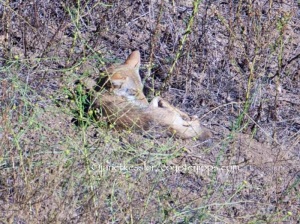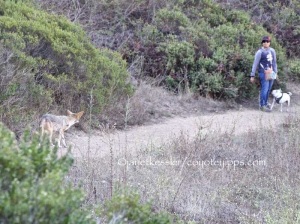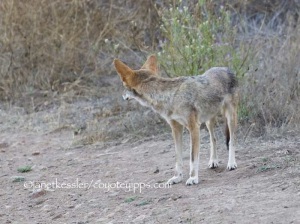- A dad resting on a hillside while keeping his eyes on things
- A dog in the distance worries him
- He hurries in the dog’s direction
- He follows
- Dog’s owner turns around and faces him and tells him to “Go Away” loudly
- Dad coyote turns away after owner’s second attempt
The Behavior
Dad coyotes are out for a while in the mornings to perform “sentry duty”. With so many dogs in the parks, you can be sure Dads are concerned and worried about the areas where youngsters have been stashed to stay safe.
Most of the time, a dad will just lie and watch, sometimes with one eye shut, from a location with a broad view. He is not only watching, he is also making himself visible. Making himself visible during this time frame is a communication device for letting others know that he is there — the territory is taken. This is about territorial behavior — about protecting one’s turf.
During the time that he’s lying there, he may become uneasy over a particular dog he’s spotted in the distance. If this happens, he’ll sit up or stand to watch more keenly. This may be all he does before lying down again. However, being the good caregiver and guardian that he is, he may hurry after the dog and follow to assure himself that the dog is headed away from, and not towards, a pupping area — sort of “escorting” the dog away.
If the dog owner is not vigilant, the coyote could get close and might even deliver a messaging nip to the dog’s behind — cattle-dog fashion — to get the dog to hurry along. All dog owners should be aware of the possibility of this behavior. Remember that coyotes don’t allow other coyotes into their territories: If YOU were not there with your dog, the coyotes would be trying harder to let the dog feel unwelcome. This does not happen frequently, but I’ve seen it a number of times.
What To Do
What should a dog owner do? I’ve posted this before, but it needs to be emphasized. Remember that coyotes are not interested in tangling with humans — rather, they want to message the dog. First and foremost, if you see a coyote, always leash and continue moving away from it. You should keep your dog in sight at all times. Don’t let your dog lag far behind you where he’s out of your line of vision.
If you see a coyote following and getting too close, you need to stop and shoo it away. Simply turn around and glare at the coyote. Eyeball him eye-to-eye to let him know you mean business and that you are targeting him. You can add emphasis by lunging or stepping towards the coyote. You want to move in his direction without getting close. One walker recently told me that she pointed at the coyote by extending her arm out far and pointing her finger at the coyote in a commanding sort of way as she stamped her foot and lunged at a coyote. By eyeing the coyote and pointing at it, there will be no mistake about who your message is for. Picking up a small stone and tossing it in the coyote’s direction is always effective. Either way, you are moving in his direction, or moving something in his direction, which is what causes him to move. Then turn around and walk on, but continue looking back. If he continues to follow, you should repeat this more emphatically — it may take several attempts before the coyote gets the message. Never run from a coyote.
NOTE, that if a coyote is close enough to engage with your dog, you’ll need to be ferocious in your shooing it off. Please see the demonstration in the “Coyotes As Neighbors” YouTube video (you can google this). It’s best never to let a coyote get this close in the first place.








